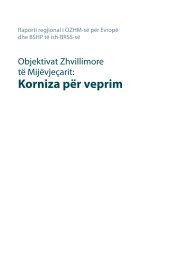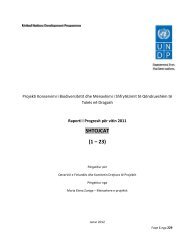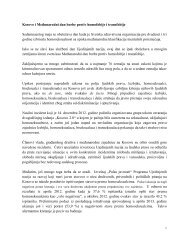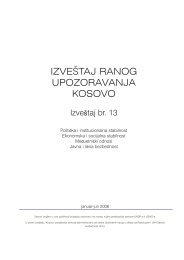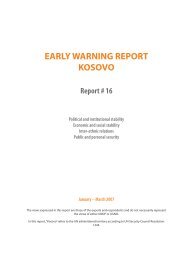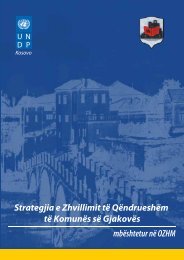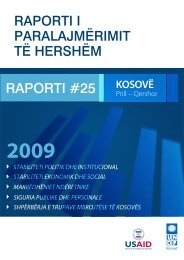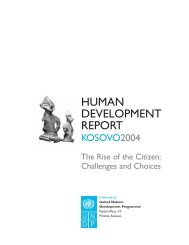Kosovo Human Development Report 2010 - UNDP Kosovo - United ...
Kosovo Human Development Report 2010 - UNDP Kosovo - United ...
Kosovo Human Development Report 2010 - UNDP Kosovo - United ...
You also want an ePaper? Increase the reach of your titles
YUMPU automatically turns print PDFs into web optimized ePapers that Google loves.
point these groups more precisely, in<br />
order to identify potential mechanisms<br />
for their inclusion.<br />
(i) Children with special needs: according<br />
to OECD research based<br />
on comparative country analysis,<br />
in order to equip disadvantaged<br />
students with equivalent learning<br />
means, even in cases of severe disabilities,<br />
they should be educated<br />
in mainstream schools rather than<br />
in separate institutions. 98 The education<br />
of Kosovan children with<br />
special needs, as in many countries<br />
in the region, has historically been<br />
a neglected area. Prior to 1999 and<br />
immediately after the armed conflict,<br />
children with special needs<br />
were either accommodated in the<br />
small number of special schools, or<br />
were unable to attend school at all.<br />
The policies and practices of classification<br />
and placement of students<br />
with special needs were based<br />
mostly on the medical model of<br />
disability and did not encourage<br />
inclusion. In some cases children<br />
with minor disabilities were enrolled<br />
in mainstream schools without<br />
any special accommodations<br />
made for their educational needs. 99<br />
Despite the current legislative progress,<br />
children with disabilities continue<br />
to have a high percentage of exclusion<br />
in education. The barriers to social inclusion<br />
that children with disabilities<br />
face are poverty, lack of resources and<br />
aid, lack of transportation to and from<br />
educational facilities, cultural attitudes,<br />
lack of special training for teachers,<br />
and absences of appropriate infrastructure.<br />
100<br />
As a result, only 10 percent of children<br />
with disabilities are enrolled in<br />
mainstreamed schools. 101 The success<br />
of ‘mainstreaming’ some groups of chil-<br />
An important issue is that even if laws exist, they are not<br />
necessarily applicable to disabled people, e.g. the law<br />
on Education. The Municipality doesn’t provide access<br />
for people with disabilities; even schools do not have the<br />
necessary capacities to provide us with needed access. I am<br />
not even talking about special restrooms and lifts, which are<br />
nonexistent.<br />
Disabled participant of a focus group<br />
dren with special needs and reducing<br />
the amount of segregated schooling<br />
could be challenged when there are<br />
no special budget allocations to support<br />
inclusion of these groups. In total,<br />
909 children with special needs enrolled<br />
in the school system in 2009/10<br />
(up from 508 in 2002). Of these, 57<br />
percent are in special classes in mainstream<br />
schools and 43 percent in special<br />
schools. Most of the children have<br />
intellectual disabilities. Gender inequalities<br />
are high with girls accounting<br />
for only 35 percent of the total.<br />
(ii) Minority children: grave inequalities<br />
persist in access to education<br />
among ethnic groups. In 2005,<br />
almost all <strong>Kosovo</strong>-Albanian and<br />
<strong>Kosovo</strong>-Serb children were enrolled<br />
in primary school. By contrast, only<br />
77 percent of children aged 7-14<br />
among other ethnic groups (RAE,<br />
Turk, Bosniak, Gorani, and others)<br />
attended schools. Registration for<br />
girls among these groups was even<br />
lower - at 69 percent. 102 Children<br />
from non-Serb ethnic minorities<br />
also spend less time in education<br />
than their counterparts. According<br />
to the <strong>UNDP</strong> Mosaic Survey (2009),<br />
<strong>Kosovo</strong>-Albanians have spent an<br />
average of 11.5 years in education,<br />
<strong>Kosovo</strong> –Serbs 11.2 years, and other<br />
minorities just 10.6 years. 103<br />
Of all ethnic groups, <strong>Kosovo</strong>-RAE<br />
children face the most complex barriers<br />
to inclusion in education. <strong>Kosovo</strong>-<br />
ACCESS TO EDUCATION AND EXCLUSION<br />
| 59



